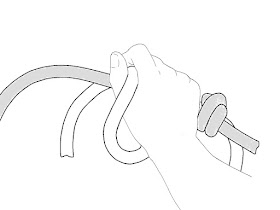The one handed clove hitch demonstrates how the hand can be used reliably like a knot tying machine. The strategy is to put your natural hand movements into sequence. From this, two beneficial dynamics emerge: 1) bight on bight tying builds knots faster than reeving the end of the rope 2) consistent hand movements embed knot memory (like a piano player). Moreover, this builds your preparedness skills.
Here's the video version as a reference:
http://www.youtube.com/watch?v=K-4RMnULYIM
The opening move is to capture a bight of rope on your small finger. This simple step leaves the majority of your hand available for more work.
Holding your small finger fixed in space, rotate your hand in the direction that your palm faces. Think of this move as the thumb sweeping out an arc as it points down. Once the thumb reaches the down position, your middle three fingers grasp the rope.
Now rotate the thumb back up, while maintaining that three finger grasp. A loop will form. Note how your small finger positions underneath the point of intersection. Open your middle three fingers. You have just captured the first loop of the clove hitch. Moreover, this loop represents the start of numerous other knots.
Curl your hand to scoop of the left strand of rope.
When your thumb returns to the up position, you're now holding a bight on the outer part of your fingers. In total, a loop plus a bight is being held. This forms the Munter hitch. To complete the clove hitch, that bight needs to be turned into a loop. The target is to move the left strand inside the palm of the hand.
Insert your thumb to lift the bight off of your fingers.
Now the work of rotating the bight begins. Squeeze your middle fingers deep inside the palm of your hand. This serves to force a twist into the bight - resting on your thumb.
As the squeeze is completed, the rope slips off the thumb. The thumb nudges the rope back onto the fingers. This action transfers a loop on your fingers. You're now holding two identically shaped loops on your hand. These two loops are the components that make the clove hitch.
By straightening your middle three fingers, the clove hitch is dressed into position. It's ready to use.



























































